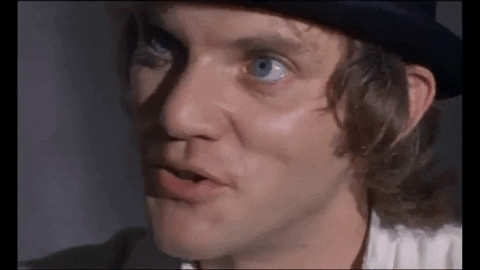- Please Consume
- Posts
- Tell me what you had in mind.
Tell me what you had in mind.
We’re starting out this week with a big one. Like one of the biggest ones. When we were pitching the best slow-motion walks in film this was obviously one of the first to come up. But also... What a daunting task!


Good morning Consumers. this is Please Consume, The newsletter that loves movies as much as David Cross hated being in Alvin & The Chipmunks: Chipwrecked


A Clockwork Orange (1971)

We’re starting out this week with a big one. Like one of the biggest ones.
When we were pitching the best slow-motion walks in film this was obviously one of the first to come up. But also… What a daunting task!
Covering Stanley Kubrick is always difficult, but especially with a film that is so iconic and revolutionary while simultaneously so transgressive and, at times, completely tasteless.
It feels strange to even give you the plot of a film that is so ubiquitous in our culture, so instead let’s just hop into what makes this film the behemoth that it is today.

Building an icon

As I’m sure we all already know, A Clockwork Orange is an adaptation of an Anthony Burgess novel from 1962.
But just because it’s an already famous text does not mean Kubrick won’t change it for the sake of control. He's done it before and would go on to do it again.
Some of the biggest changes are what caused this film to stick in the cultural zeitgeist for all these years.
For one, Kubrick actually softens our protagonist from how he’s depicted in the book.
This is likely due to the fact that he wants us to be able to connect with the character, to make him just likable enough that you’ll see him through to the end. This trick is similar to previously covered films like Adam Sandler in Uncut Gems or Ewan McGregor in Trainspotting (which was heavily influenced by A Clockwork Orange).
The other change he makes from the book that lends itself to iconography is the look of the characters and the film.
In her 2011 paper, “A Clockwork Orange: The Intersection Between a Dystopia and Human Nature”, writer Samantha Moya says:
“A Clockwork Orange differs from the standard prototype of the dystopian sub-genre. First, the novel is self-described as a society in its pre-dystopian hours, in the beginnings of totalitarianism. Secondly, the audience perceives the world through an adolescent lens. Alex, a fifteen-year-old criminal, is the protagonist of the story, a youth who fights to feel alive in a corrupt society that he does not quite understand. Through these two paradigms, Burgess shows the audience that the prime characteristic that marks a society as ‘dystopian’ is the lack of moral choice.”The film still retains many of these concepts, but instead chooses to show the idea of a pre-dystopian future visually. Its absurd bright colors and garish looks actively bump against the more Regency-based world in which they live.
The book leans into this by having its characters dress “properly” with top hats and cravats. On the other hand, the film actively rejects it with the character’s obscene all-white ensembles and gratuitous breast milk dispensers.
Add that to the omniscient way the film is shot vs the book which is completely subjective to the point of having an unreliable narrator.
To put it simply, if the book shows us an overly proper world as seen by a reckless young man, the movie shows us a reckless world perfect for a reckless young man terrorizing the overly proper till the overly proper terrorizes him.
Why This Walk?

Seeing that this is Slow Motion Walks Week, we want to dive into what makes these walks so important.
What makes A Clockwork Orange work so well, besides its riveting iconography, is the way it Uno-reverses what it’s conveying to the audience.
It starts out as terror with its frantic soundtrack, its narration teasing mayhem to come, and its characters walking straight to camera, almost stalking the audience.
One shot later the evil within is still conveyed but now the music feels less frantic and more childish.
Their actions don’t feel malicious, they feel prepubescent.
They’re the actions of a schoolyard bully just looking to get detention or suspended.
All this is shown brilliantly in slow motion, so what is happening in a matter of moments stretches for a full minute and a half.

Todays Scene
Stream It
If you would like to watch A Clockwork Orange at home, you can find it here.


Guess Tomorrow’s Film

Reply to this email with your guess of what Tomorrow’s film will be.